
April 2010
John Vincent Bellezza
This issue of Flight of the Khyung moves west beyond the legendary realm of Zhang Zhung to take a retrospective look at culture in the Hindu Kush mountains. Our focus is Indus Kohistan, a region of northern Pakistan that once had strong ties to Buddhism and which also seems to have had cultural exchanges with pre-Buddhist Upper Tibet. The presence of ancient Burushaski place names in the region indicates that Indus Kohistan was once part of Brusha (Brushal), a region that according to Eternal Bon literature played a major part in the demographic makeup of Zhang Zhung.
A traverse of the Hindu Kush Range in Indus Kohistan
The narrative that follows is taken from my journal 15 and was picked at random from fifty volumes of writings. This snippet of an adventurous journey made 20 years ago happily skips between traditional culture and the modern in the Hindu Kush:
July 14, 1990
…We are right at the base of two approximately 4400 m passes. Inshallah, one of them we will cross tomorrow. The Tangier valley is very pretty, so much so that I wonder how violence can prevail here. I suppose in his ignorance Man can be oblivious to nature’s beauty. The mountains reach a height of 5000 m and are generally not glaciated. Have any Westerners come this way since Independence? While walking today we witnessed men fishing. A group of men formed a row across a branch of the river and jabbed the water with sticks. The men pushed up the dead-end branch hollering and hooting until the fish were driven into a pool with no outlet. The fish of this river are only 10 to 20 cm long.
Quartz crystals are common in Tangier. Several people have shown them to us wondering if they are valuable. According Abdul Gufaw (a local luminary), five varieties of wild vegetables grow in the forest [this time of the year]. The people tell me that there are many kinds of medicinal plants, but as usual they are not familiar with them. However, I am informed that there are a couple ‘experts’ [left in Tangier]. From Satil the valley branches. One way goes to Bataret, and ours, the longer route, heads to Chash. Barabar at the base of the two Chash passes is above the tree-line and perhaps at 3300 m elevation. Munzer’s porter wanted extra money. He used the Arabic word harait (goodwill) to press his case. To avoid problems Munzer gave him another 20 rupees.
What exists of the ancient Dardic culture of Tangier? Here is some fascinating information given to me by a man we met on the trek today. The malik (owner) of the valley is a jinn (spirit) called Abulajan. Other benevolent and wrathful spirits of Tangier are Afarad and Saipur.* Possession by devils is said to occur. A hap is an oracle who predicts the future in dreams. A dum is a person who heals by magic. How prevalent are these occupations and the mystic phenomena they represent?
July 15
…Last evening we tentatively arranged a porter to carry Munzer’s rucksack over the pass. The man came this morning but Munzer did not notice him. Consequently, we found ourselves without anyone to help us. The only alternative seemed to be to shoulder the burden ourselves and look for the pass on our own. Munzer started out alright but as the gradient increased, he slowed to a snail’s pace. I implored him to dump any unessential items but he refused. I was contemplating leaving my friend behind when several good Samaritans appeared on the scene. I was later to learn that that the Hajji we talked to last night was watching us from his camp with binoculars. When he saw Munzer stalled he came up to help.
Without Hajji Munzer could never have made it over the pass. Hajji, an extremely strong middle-aged man and his two companions took turns carrying Munzer’s pack and helping him up. Hajji who has made pilgrimage to Mecca twice devoted his entire day to helping us. He refused all payment and his good sense of humor and cheer were an inspiration. What a good man! I am touched to see a man [anywhere] who really lives his religion…
July 16
A glorious clear and still morning. Fortunately, Munzer is not suffering from altitude sickness. He slept well and his appetite is good – too good because now he has a stomachache. Last night I made a stew for dinner and this morning fry bread. A couple days ago it was looking like we had too much food, but now I am glad we brought it. You cannot unequivocally depend on the natives for food. It is simply not fair or practical.
Like in Chiral, there are both Muslim and non-Muslim jinns. Some are considered allies and some are enemies. I hunger to know more about pre-Islamic Dardic culture. In Gilgit I hope to avail myself of every resource possible to learn more. In Islam, as in Judaism and Christianity, man was created from a clod of earth. Jinns according to Islam were created from fire and are not visible to people. How Islamized is the ancient Dardic pantheon? What remnants in the religion, folklore and mythology of [Kohistan] have survived? Have the Dardic elements been synthesized or has a syncretistic organism developed? I must know more. In Chitral, pre-Islamic components have been melded to Islam wherever possible but isolated when there is not an Islamic priori. For example, parehans (fairies) have roles that are both Islamic and non-Islamic, as do the jinns.
It is difficult to estimate the size of the lake we are camped by, but it is bigger than Chandra Tal, the largest natural alpine lake in Himachal Pradesh. The 5000 m peaks are not much higher than our camp. I could run up one in a couple hours. I feel pleased that I have made it over another Kohistani pass and to have visited the largest valley of the region (Tangier). The lakes are an unexpected boon.
We have a couple of visitors. They are walking towards us at this very moment. The man and boy seem to be heading to Chash. Of course they ask the basic questions. From what the pleasant looking man says, he has livestock grazing in the Chash valley. I suspect that the more gentle Gilgitis were pushed out of most high pastures on their side of the [Hindu Raj] range many years ago.** The Gilgitis abhor violence while the Kohistanis often find recourse to it. The domestic forts and guns divert resources that could be employed in education and development. I see nothing functional in feuding except as a savage means of population control.
On the other hand, my personal experiences in Kohistan dictate that I do anything but disparage the people. The sanity and unity that emanates from their tribal character and organization is praiseworthy. An austere life made more austere by homicidal tendencies has worked to give the people a keen sense of priorities. They will survive when many others give up due to their extraordinary grit and determination. What troubles me most about Kohistan is the population explosion, deforestation and lack of educational opportunities. These three things will increasingly work against the people in the coming years. Education, conservation and peaceful methods for resolving conflicts could save the Kohistanis from ruination. I see no other solution to the mounting development problems.
What looks like the end of the lake from our camp is actually a narrow strait which separates a narrow ovoid arm from the main body of water. I foraged for scallions and rhubarb on a verdant slope high above the lake. More than a dozen types of wildflowers are in bloom including dandelions and anemones. On a color-spangled slope I found good things to eat…
July 17
Around dawn it hailed heavily. Now again it is still and the sun is peeping out from behind the clouds. I hope Munzer is feeling better. Today we should head down to the Gilgit valley. Cairns mark the pass. The other day Hajji told me that they have no religious connotations. Is this entirely true? Natives passing through the high valleys will stick flowers in their hats. This custom prevails all over the Northern Areas and must have an ancient origin. The weather turned inclement again. We packed and dismantled our tent while it drizzled. The first leg of the trek was to get around the lake. Nearly the entire lakeshore is marshy so the going is a little slow. The second leg of today’s trek was to descend from the lake basin into a wide grassy valley. The declivity was gentle and only about 200 m vertical. For about 10 km we trudged across the verdant marshy valley. The final leg of the journey was the steep descent from the Saroga valley to the Chash valley. Munzer was slow again today. I waited for him at least half an hour four different times.
As soon as we dropped into the Chash valley we were greeted by a gaggle of shepherds. Two of them carried our packs to their nearby encampment. We have been given shelter inside a stone enclosure next to the masjid. The two brothers who manage the camp are very fine people. They have made us feel comfortable and at ease. I am gratified that they have taken the time to answer my questions. Another man who seems very shy is a dum. He said a prayer over a glass of water and gave it to Munzer to drink. A fire has been kindled for us. This is a special treat because wood is so scarce…
I am informed in the most direct terms that all families in Kohistan are involved in feuds. As our host said, “We all have enemies”… Both Munzer and I noticed that the Kohistanis seem more relaxed in the pastures than they do in their villages. Seldom do men carry firearms in the high country while the village men are often brandishing guns. In general, I find the children unnaturally somber. Their serious countenances seem out of place for children. The onus of vindication falls on successive generations. Many of these children must learn to kill to fulfill their duty. I think that this must be a tremendous psychic burden for a child.
I was given goat milk and corn bread for dinner – a common shepherd’s fare all over the greater Western Himalaya. Munzer had plain bread and tea on account of his unsettled stomach. One of the brothers recounted how a Japanese tourist who came to Jagalot was frightened away by the authorities. The brother said the police told the Japanese that he would be killed by the Kohistanis. He added, “We are a proud and honest people who would not rob a traveler for his luggage. What profit is there in this?” My three visits to Kohistan corroborate the brother’s words. My experiences show the people to be impeccably honest and hospitable. However, I also know that the Kohistanis are potentially volatile and dangerous. The brother agreed with this assessment and also with the comparison that the Ishmailis are gentler [than his people]. Honesty especially when it hurts is a superior quality.
* Author’s note: the names of these Tangier spirits are derived from Arabic, Persian and Indo-Aryan languages, reflecting the cosmopolitan history of Indus Kohistan. The ‘la’ in Abu-la-jan appears to be derived from the Tibetan bla, joining the Arabic abu (father) to the Persian jan (beloved, life in a poetic sense), and can probably be translated as ‘Beloved Father Spirit’.
** The Hindu Raj is the easternmost extension of the Hindu Kush mountains.
Ancient ceremonial structures of Upper Tibet and Indus Kohistan
Cultural affinities between Upper Tibet and Indus Kohistan are graphically documented in rock art. There are two main classes of ceremonial structures common to both regions: primitive tiered shrines probably dating to the protohistoric period (100 BCE to 600 CE) and chortens (mchod-rten) that are datable to the imperial period (early 7th century to mid-9th century CE). An excellent cross-section of these ceremonial monuments in Indus Kohistan has been published online by the German researcher Volker Thewalt at: http://www.thewalt.de/chilas1.htm.
Here I include five such specimens of rock art from the western and eastern ends of Upper Tibet (they occur in the middle of the Changthang as well). One of my upcoming projects is a comprehensive study of ceremonial monuments depicted in Upper Tibetan rock art, drawing from my large collection of images and diagrams made over the last 15 years. The primitive tiered shrines appear to be the precursors of the Eternal Bon gsas-mkhar/lha-rten classes of shrines, which are traditionally attributed to Zhang Zhung. The rten-mkhar, village shrines found throughout the Tibetan world, can probably be traced to this rock art as well.
The rudimentary chortens of northern Pakistan, Ladakh and Upper Tibet rock art are culturally non-Buddhist in orientation. They appear to have been created by interrelated cult groups that used the counterclockwise swastika as a prime symbol of identification. As regards Upper Tibet, I refer to this religious affiliation as the ‘archaic religious traditions’ or ‘archaic bon’ (see my book Zhang Zhung and a forthcoming work, Tibet before Buddhism).
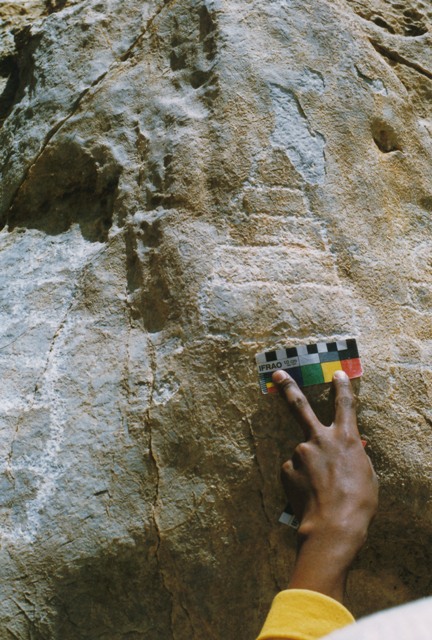
Brag-gyam chorten no. 38, Ru-thog
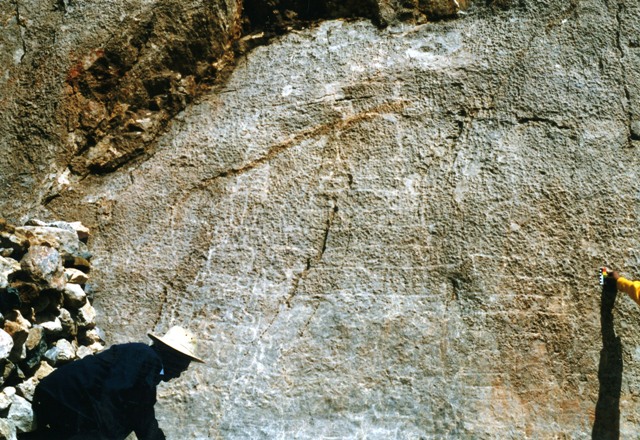
Brag-gyam, chortens nos. 23-27 (left to right), Ru-thog, probably Imperial period
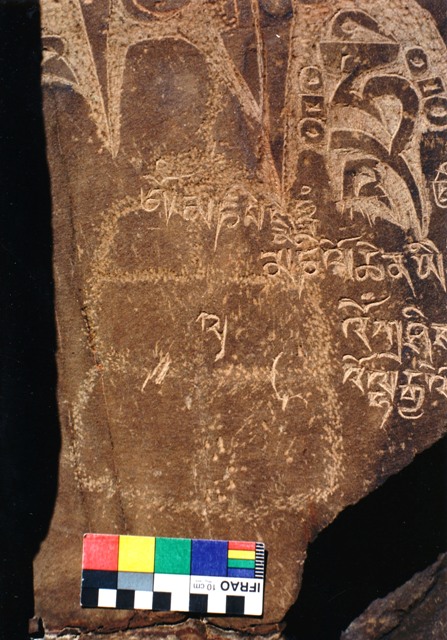
Carving of primitive shrine with superimposed Tibetan mantras, Ra-‘brog ‘phrang, Ru-thog
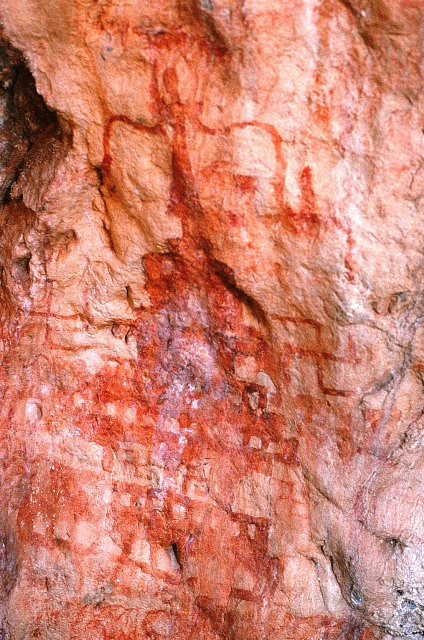
Elaborate archaic religious chorten (note the reverse swastikas), bKra-shis do, gNam-mtsho. Imperial period
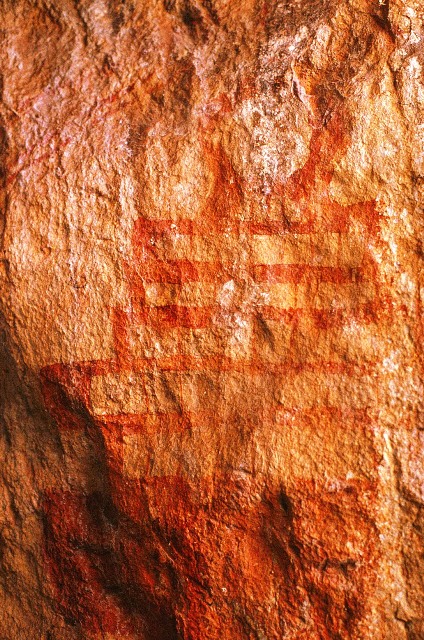
Rudimentary red ochre chorten or other type of shrine at bKra-shis do, gNam-mtsho